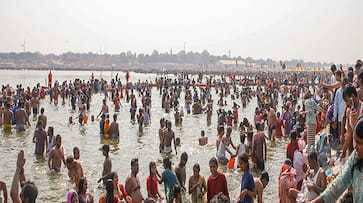 Over 620 million devotees have taken a holy dip in the sacred waters of Triveni at Prayagraj Maha Kumbh so far. Thousands of four-wheelers have also marked their presence in the Kumbh area. Despite such massive footfall and vehicular movement, the air quality in Maha Kumbh Nagar has not deteriorated, reveals data released by the Central Pollution Control Board (CPCB).More than 60% of the country's population has visited the sacred confluence of rivers at Maha Kumbh and participated in the ritualistic holy dip. Additionally, millions of vehicles have moved across the region. However, the air quality of the Kumbh area has not turned unhealthy. reports from the CPCB validate this fact.Environmental Consultant Engineer Shaikh Shiraz from CPCB stated that air quality has remained in the green zone throughout the Maha Kumbh. According to him, the Air Quality Index (AQI) on significant dates was:• 67 on January 13 (Paush Purnima)• 67 on January 14 (Makar Sankranti)• 106 on January 29 (Mauni Amavasya)• 65 on February 3 (Basant Panchami)• 52 on February 12 (Maghi Purnima)It is worth noting that an AQI below 100 is considered good, while 100 to 150 is categorized as moderate. Except for Mauni Amavasya (when the AQI was slightly moderate), the air quality on all other days was classified as good. Overall, the Maha Kumbh area remained in the green zone for 42 days.Despite the continuous influx of devotees and the presence of numerous fuel-powered vehicles, the city’s air quality remained in the green zone for 42 consecutive days. A comparative analysis of air quality data from January and February on the CPCB’s official app 'Sameer' highlights that Maha Kumbh's air quality was even better than Chandigarh’s.On key religious dates, Chandigarh’s AQI was recorded as:• 253 on January 13 (Paush Purnima)• 264 on January 14 (Makar Sankranti)• 234 on January 29 (Mauni Amavasya)• 208 on February 3 (Basant Panchami)• 89 on February 12 (Maghi Purnima)The effective air pollution control measures at Maha Kumbh were the result of regular monitoring and multiple initiatives by the Prayagraj Municipal Corporation.According to Ram Saxena, Junior Engineer of Prayagraj Municipal Corporation, the following measures were implemented:• 9,600 personnel were deployed for sanitation and pollution control.• 800 additional sanitation workers remained active throughout.• Continuous water sprinkling was carried out in areas prone to air pollution.• Road washing at night was done to minimize dust.• Water tankers from Jal Nigam were used, including eight large (10,000 liters each) and four small (3,000 liters each) tankers.• Anti-pollution sensors were installed at three key locations – MNNIT Crossing, Teliyarganj, Jhunsi Awas Vikas, and the Municipal Corporation office – where water sprinkling was conducted daily.These proactive measures ensured that Maha Kumbh 2025 set a new benchmark in air pollution control, making it an eco-friendly event despite the massive gathering of devotees.
Over 620 million devotees have taken a holy dip in the sacred waters of Triveni at Prayagraj Maha Kumbh so far. Thousands of four-wheelers have also marked their presence in the Kumbh area. Despite such massive footfall and vehicular movement, the air quality in Maha Kumbh Nagar has not deteriorated, reveals data released by the Central Pollution Control Board (CPCB).More than 60% of the country's population has visited the sacred confluence of rivers at Maha Kumbh and participated in the ritualistic holy dip. Additionally, millions of vehicles have moved across the region. However, the air quality of the Kumbh area has not turned unhealthy. reports from the CPCB validate this fact.Environmental Consultant Engineer Shaikh Shiraz from CPCB stated that air quality has remained in the green zone throughout the Maha Kumbh. According to him, the Air Quality Index (AQI) on significant dates was:• 67 on January 13 (Paush Purnima)• 67 on January 14 (Makar Sankranti)• 106 on January 29 (Mauni Amavasya)• 65 on February 3 (Basant Panchami)• 52 on February 12 (Maghi Purnima)It is worth noting that an AQI below 100 is considered good, while 100 to 150 is categorized as moderate. Except for Mauni Amavasya (when the AQI was slightly moderate), the air quality on all other days was classified as good. Overall, the Maha Kumbh area remained in the green zone for 42 days.Despite the continuous influx of devotees and the presence of numerous fuel-powered vehicles, the city’s air quality remained in the green zone for 42 consecutive days. A comparative analysis of air quality data from January and February on the CPCB’s official app 'Sameer' highlights that Maha Kumbh's air quality was even better than Chandigarh’s.On key religious dates, Chandigarh’s AQI was recorded as:• 253 on January 13 (Paush Purnima)• 264 on January 14 (Makar Sankranti)• 234 on January 29 (Mauni Amavasya)• 208 on February 3 (Basant Panchami)• 89 on February 12 (Maghi Purnima)The effective air pollution control measures at Maha Kumbh were the result of regular monitoring and multiple initiatives by the Prayagraj Municipal Corporation.According to Ram Saxena, Junior Engineer of Prayagraj Municipal Corporation, the following measures were implemented:• 9,600 personnel were deployed for sanitation and pollution control.• 800 additional sanitation workers remained active throughout.• Continuous water sprinkling was carried out in areas prone to air pollution.• Road washing at night was done to minimize dust.• Water tankers from Jal Nigam were used, including eight large (10,000 liters each) and four small (3,000 liters each) tankers.• Anti-pollution sensors were installed at three key locations – MNNIT Crossing, Teliyarganj, Jhunsi Awas Vikas, and the Municipal Corporation office – where water sprinkling was conducted daily.These proactive measures ensured that Maha Kumbh 2025 set a new benchmark in air pollution control, making it an eco-friendly event despite the massive gathering of devotees.